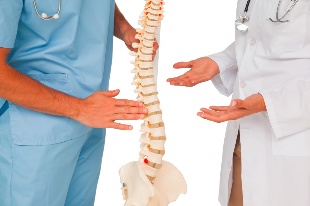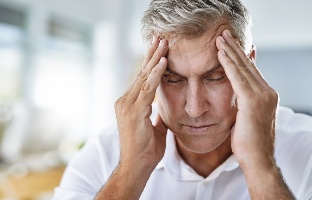
Many people associate the word "osteochondrosis" with age. There is an opinion that this is a disease of grandparents who "shoot in the lower back" and "back pain". However, there is only a grain of truth in this misconception: indeed, osteochondrosis isdegenerative(i. e. , caused by a local metabolic disorder)changes in the spine, which inevitably occur in all older people. However, osteochondrosis is now found in 9 out of 10 people older than 45, and the first manifestations of the disease can begin as early as 25 years of age.
This disease is even called"civilization disease" because the main cause of osteochondrosis is improper "utilization" of the spine. The fact is that the modern person exposes him to excessive loads and, paradoxically, not when he runs or lifts weights, but when he sits without getting up from his chair for hours. This load is calledstaticand is very inconvenient. Because a person thinks he is resting while sitting. But in fact the spine in a sitting position works with increased stress.
How the spine works
To understand what osteochondrosis is, you need to understand what the human spine is. We all know that the spine is made up of vertebrae that are connected in series by intervertebral discs. In total, a person usually has 33-34 vertebrae: 7 of them make up the area of the cervix, 12 - the area of the chest, 5 (or 6 in a small percentage of people) - the lumbar part, another 5 vertebrae, which grow together, form the sacrum and, finally, the coccygeal region consists of five (or four - depending on individual characteristics) vertebrae. The vertebrae are actually bones and they are immobile, but in order to be able to move freely, providing mobility to our whole body, and also not to collapse from impact and friction, between each vertebra there is a layer of gelatinous substance (so-called. nucleus pulposus) surrounded by strong multilayered plates (annular fibrosus). Together this is called theintervertebral disc.In addition, the structure of the spine contains numerous ligaments, vessels, nerves. This is a very complex organ that largely determines the work of almost all body systems, because it protects the spinal cord and affects its work.

Vertebrae and intervertebral discs are continuously renewed throughout a person's life. This is possible due to the fact that they are well supplied with blood and always have a good diet. However, if for some reason the diet begins to enter the spine in insufficient quantities, the nucleus pulposus loses properties, the intervertebral disc becomes flat and less elastic, cracks appear in the ring, and the vertebrae themselves begin to move in different directions and closer to each other. All this leads to a number of dangerous deviations - primarily toinflammation both in the spine and in the surrounding tissues, and to the compression of the spinal cord and spinal nerves.
It is interesting that such a concept as "spinal osteochondrosis" exists mainly in the post-Soviet space. In the foreign literature, the changes that occur in the spine are called"hernias", "myofascial pain", "disc injuries", "dorsopathy". So, if you have heard something similar about yourself, then you have osteochondrosis of the spine. As forintervertebral hernia, it is considered to be one of the stages of osteochondrosis.
The disease has no acute course and develops gradually: first the intervertebral disc narrows, becomes degeneratively altered, thenprotrusions appear- the nucleus pulposus appears to be displaced and mixed with the fibrous ring, but is notinterrupts. When an annular fibrosus ruptures, they speak of anintervertebral hernia.In the last, most severe stage of osteochondrosis,the intervertebral discs are completely worn out, the vertebrae begin to rub against each other and also collapse, pathological bone growths and osteophytes appear on them. In the last phase, the spine is, so to speak, "petrified", ie it loses mobility, which can lead to disability.
Causes of Spinal Diseases
For what reason do all the abovedegenerative changes occur?As already mentioned, the main reason isabnormal load on the spine:for example, when a person has to sit a lot in uncomfortable positions, "hunched over", the cervical and thoracic regions experience tension and lack nutrition. In addition, osteochondrosis can develop due to poor posture.However,sports, especially strength sports, with a violation of exercise technique, can also lead todegenerative changes in the spine
Another common cause is anyback injury. The development of osteochondrosis can also be influenced byhereditary genetic predispositions, hormonal disorders, excess weight, unhealthy diet, insufficient water intake and, as a result, dehydration, smoking and alcohol abuse.
Women often encounter the first manifestations of osteochondrosis during pregnancy, and then, when young mothers have to feed their baby in uncomfortable positions for themselves and often carry it in their arms, the condition of the spine noticeably worsens.
Symptoms of osteochondrosis
The symptoms of osteochondrosis are different and depend on which department the disorders occurred in. Pain is the main manifestation of this pathology, however, as long as therupture of the annular fibrosusis not mild, it can be tiring, oppressive, and patients may not pay attention to it.More often the pain intensifies in the morning or after physical exertion, radiating to the arms, legs, neck, ribs and chest (in this case osteochondrosis can easily be confused with coronary heart disease).
In addition, numbness and tingling may occur in the limbs.
Osteochondrosisin the cervical spinemay cause headaches, sometimes very severe, dizziness, nausea, wheezing in the ears. The development of a hernia, which leads to compression of the nerve endings, can lead to disturbances in the functioning of the internal organs associated with the affected nerve. For example, a hernia in the lumbar spine can cause problems with urination, loss of potency, in the chest - indigestion, in the cervical - problems with the blood supply to the brain.

Diagnosis of osteochondrosis
Only a doctor can distinguish osteochondrosis from other diseases of the internal organs and determine the source of pain. Today, magnetic resonance imaging is considered to be the most reliable method of diagnosing spinal diseases.
X-rays are also reliable, but less informative. You can see the changes on the intervertebral discs on the X-ray, but you cannot, for example, see the hernia and assess the condition of the spinal cord and the degree of its compression by the displaced vertebrae. In addition, MRI allows you to distinguish osteochondrosis from other dangerous diseases, including malignant formations and ankylosing spondylitis.
Can osteochondrosis be cured?
Unfortunately, osteochondrosis is impossible to cure, but it is possible to alleviate the patient's condition andstop further destruction of the intervertebral disc, but this requiresto completely change the way of life - regularly engage in physical therapy, by swimming, attending massage courses or manual therapy, start eating properly and give up bad habits. Sports, massage, proper nutrition, and weight loss can have a significantly greater and longer-term healing effect than medication.
Doctors are still arguing over the effectiveness of chondroprotectors - drugs that repair cartilage tissue and reportedly strengthen ring fibrosus, their effectiveness has not been sufficiently proven, but since they definitely do no harm, they can be used to treat osteochondrosis.
For severe pain, your doctor may prescribe non-steroidal anti-inflammatory drugs (NSAIDs), muscle relaxants (muscle relaxants) and analgesics.
They are used in the treatment of osteochondrosis andvitamins, because their lack provokes further destruction of the intervertebral disc:B vitamins, for example, help to improve protein metabolism between tissues, as well as proteinsare the main building material in the body, and then the normalization of protein metabolism contributes to the regeneration of nerve and cartilage tissue. Vitamin A improves blood circulation. However, taking vitamins, like any other medication, you need to be careful, because they can cause serious side effects, and can be taken only after consulting a doctor and under his supervision.
Surgical treatment of osteochondrosis is also possible, but, as a rule, it is resorted to whenthere is a significant narrowing of the spinal canal and excessive compression of the nerves and spinal cord caused by hernias. In this case, the situation is so severe that the patient, for example, cannot walk, the internal organs begin to fail, or there is a risk of developing a stroke. Most often, such serious consequences are caused by osteochondrosis of the cervical and lumbar spine, degenerative changes in the thoracic spine, even in the presence of a hernia, almost never require surgical treatment.
Today,methods of so-called sparing surgeryare being actively introduced into medical practice, when doctors manage to preserve the integral structure of the vertebrae by removing part of the nucleus pulposus using aendoscope. The device is inserted at the site of the spinal lesion with small incisions in the skin, which avoids large blood loss. Because the entire disc is not removed during surgery, the biomechanics of the spine are generally not disrupted, and this shortens the recovery period. Patients often get to their feet within a day of surgery. However, every spine operation is still fraught with complications and subsequent relapses of the disease, so experienced specialists will try to delay the surgical treatment until the last one. Here, too, everything depends on the patients themselves: if they follow all the doctor's recommendations and take care of their health, then they will be able to work without surgery even in the presence of a hernia.

















































